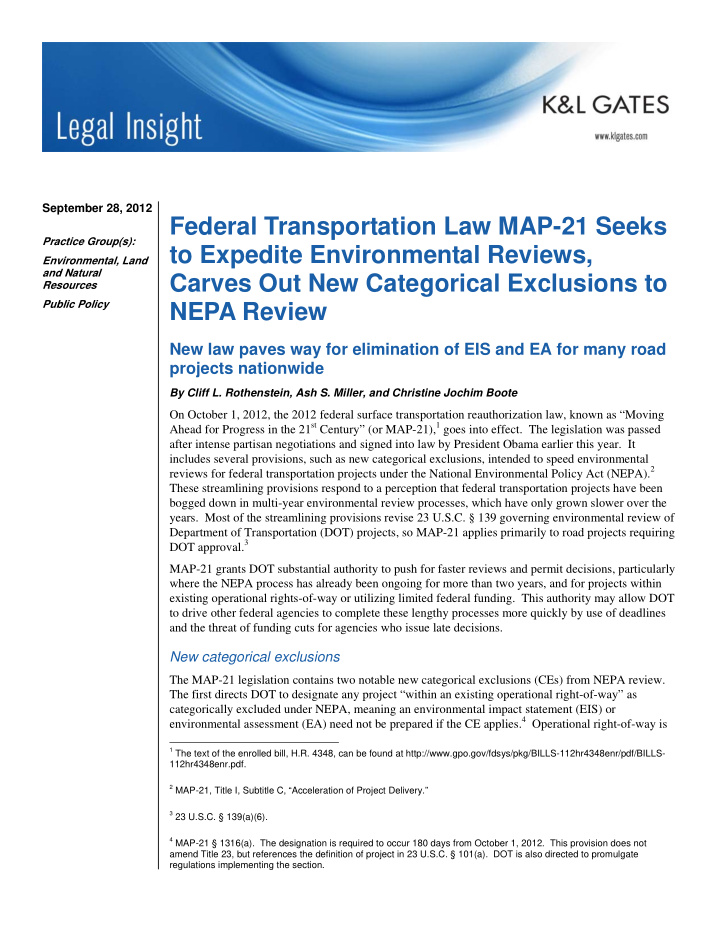



September 28, 2012 Federal Transportation Law MAP-21 Seeks Practice Group(s): to Expedite Environmental Reviews, Environmental, Land and Natural Carves Out New Categorical Exclusions to Resources Public Policy NEPA Review New law paves way for elimination of EIS and EA for many road projects nationwide By Cliff L. Rothenstein, Ash S. Miller, and Christine Jochim Boote On October 1, 2012, the 2012 federal surface transportation reauthorization law, known as “Moving Ahead for Progress in the 21 st Century” (or MAP-21), 1 goes into effect. The legislation was passed after intense partisan negotiations and signed into law by President Obama earlier this year. It includes several provisions, such as new categorical exclusions, intended to speed environmental reviews for federal transportation projects under the National Environmental Policy Act (NEPA). 2 These streamlining provisions respond to a perception that federal transportation projects have been bogged down in multi-year environmental review processes, which have only grown slower over the years. Most of the streamlining provisions revise 23 U.S.C. § 139 governing environmental review of Department of Transportation (DOT) projects, so MAP-21 applies primarily to road projects requiring DOT approval. 3 MAP-21 grants DOT substantial authority to push for faster reviews and permit decisions, particularly where the NEPA process has already been ongoing for more than two years, and for projects within existing operational rights-of-way or utilizing limited federal funding. This authority may allow DOT to drive other federal agencies to complete these lengthy processes more quickly by use of deadlines and the threat of funding cuts for agencies who issue late decisions. New categorical exclusions The MAP-21 legislation contains two notable new categorical exclusions (CEs) from NEPA review. The first directs DOT to designate any project “within an existing operational right-of-way” as categorically excluded under NEPA, meaning an environmental impact statement (EIS) or environmental assessment (EA) need not be prepared if the CE applies. 4 Operational right-of-way is 1 The text of the enrolled bill, H.R. 4348, can be found at http://www.gpo.gov/fdsys/pkg/BILLS-112hr4348enr/pdf/BILLS- 112hr4348enr.pdf. 2 MAP-21, Title I, Subtitle C, “Acceleration of Project Delivery.” 3 23 U.S.C. § 139(a)(6). 4 MAP-21 § 1316(a). The designation is required to occur 180 days from October 1, 2012. This provision does not amend Title 23, but references the definition of project in 23 U.S.C. § 101(a). DOT is also directed to promulgate regulations implementing the section.
Federal Transportation Law MAP-21 Seeks to Expedite Environmental Reviews, Carves Out New Categorical Exclusions to NEPA Review defined broadly to include “all real property interests acquired for the construction, operation, or mitigation of a project … including the locations of the roadway, bridges, interchanges, culverts, drainage, clear zone, traffic control signage, landscaping, and any rest areas with direct access to a controlled access highway.” 5 The second CE relates to any project receiving less than $5M in federal funds, or costing less than $30M with less than 15% federal funding. 6 This CE is notable because the statute only refers to funding levels here, and does not consider the geographic scope of the project or its potential environmental impacts. 7 Streamlining documentation In addition to the two CEs described above, the legislation also changes how existing CEs are administered in order to speed review. Specifically, MAP-21 directs DOT to promulgate regulations eliminating the need to “document” CEs for many types of DOT projects. This means that in order to invoke CE status, documentation may no longer be required to demonstrate that no significant environmental effects will result from the action. DOT must consider the following types of projects for possible inclusion in non-documented CEs: resurfacing, restoration, rehabilitation, reconstruction, adding shoulders or auxiliary lanes; safety or traffic operations improvements; bridge rehabilitation, reconstruction or replacement; grade separation construction to replace existing at-grade railroad crossings. 8 Depending on the extent of DOT regulations, these CE changes could be significant in scope and impact, making it simpler for projects to qualify for a CE. Together with the “operational right-of-way” CE, these exemptions could eliminate the need to prepare an EIS or EA for a broad swath of transportation projects nationwide. 9 Enforcing deadlines for review Significantly, MAP-21 imposes deadlines on federal permitting activity, and sets financial penalties for late agency action. First, MAP-21 requires all federal agencies to act within 180 days after the NEPA process is complete. 10 Failure to meet this deadline results in a financial penalty: rescission of 5 MAP-21 § 1316(b). 6 MAP-21 § 1317. The term “project” is not defined by this section. 7 MAP-21 directs DOT to promulgate regulations on this CE as well. 8 MAP-21 § 1318(c). The legislation orders DOT to revise its own NEPA regulations to the extent consistent with Council on Environmental Quality (CEQ) regulations. 9 MAP-21 makes specific reference to NEPA regulations promulgated by the CEQ and DOT, and should be read together with those regulations at 40 C.F.R. Part 1500 and 23 C.F.R. Part 771. It should be noted, however, that in the past CEs have been “documented” by studies demonstrating that the action meets the substantive requirements of CEQ regulations. Thus CEs do involve NEPA review, but not a full EIS or EA. MAP-21 also creates a CE for reconstruction of certain roads, highways or bridges damaged in declared emergencies, provided certain capacity and design characteristics remain the same as the original infrastructure. MAP-21 § 1315. 10 Specifically, MAP-21 sets a deadline of “180 days after the date on which an application for the permit, license, or approval is complete” or “180 days after the date on which the Federal lead agency issues a decision on the project” under NEPA, whichever is later. MAP-21 § 1306 (creating 23 U.S.C. § 139(h)(6)). 2
Recommend
More recommend